“The past belongs to all of us, and we all have a duty to preserve it.” These words from archaeologist Zahi Hawass highlight the urgency of the World Monuments Fund’s latest news.
The nonprofit World Monuments Fund releases its Watch list every two years. It lists irreplaceable treasures that are at risk of disappearing. The 2025 list names 25 sites that are part of our shared history, now threatened by many dangers.
What’s putting these sites at risk? Threats include armed conflicts, natural disasters, climate change, and too many visitors. Each site has a unique story of human achievement, now at risk.
Learning about these unesco world heritage sites and other landmarks helps us appreciate their beauty and fragility. The Watch list is more than a warning; it’s a call to action for people everywhere.
By focusing on these vulnerable sites, conservationists aim to get more support and resources for saving them. The next parts will explore some of the most important sites on this year’s list, showing why they’re key to understanding human history.
The Urgent Crisis Facing Our Global Heritage
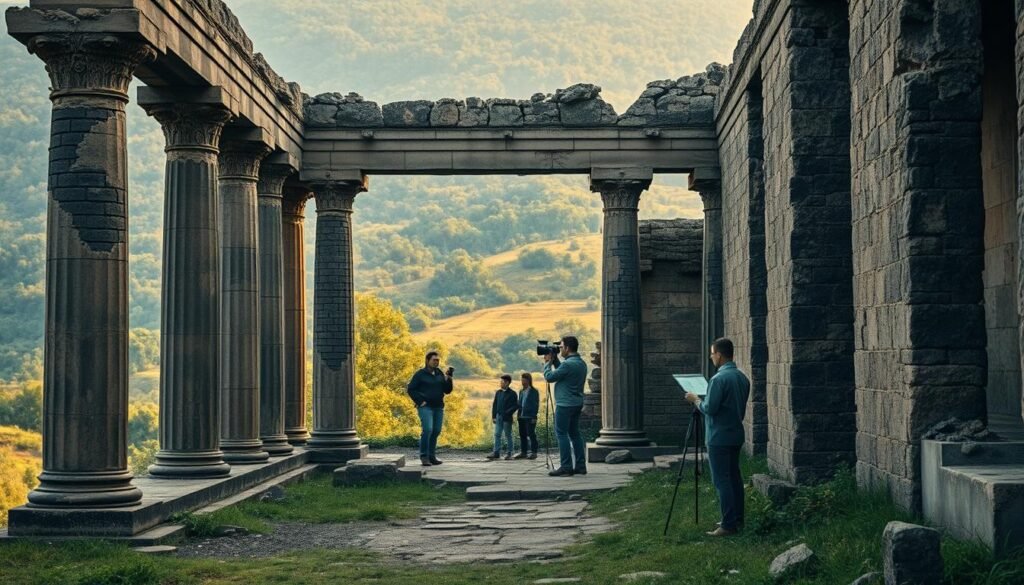
The world’s cultural treasures are at a critical point, facing many dangers. The World Monuments Watch program has listed 904 sites in 135 countries, including Antarctica, as at risk. This year, sites from Angola, Zambia, and even space are included.
The 21st century has brought new challenges to cultural preservation. Sites that lasted for centuries are now at risk in just decades or years. This creates a perfect storm that threatens our shared human legacy.
Human conflict damages ancient cities and sacred places. Climate change causes rising seas, extreme weather, and changes the environment, slowly wearing down structures. Rapid urbanization and development often ignore heritage protection for economic gain.
Mass tourism is a double-edged sword. It raises awareness and funds but can also harm sites. There’s a lack of funding and specialized skills in many areas.
When cultural heritage is lost, communities suffer. They lose economic chances, social bonds, and ties to their history. These sites are more than just buildings or artifacts; they are links to our past and identity.
Groups like the World Monuments Fund are fighting back with global conservation efforts. They offer technical help, emergency actions, and advocacy. Their work shows that saving heritage needs local knowledge and international help. As threats grow, the need to protect our shared heritage becomes more urgent.
Understanding the World’s Most Endangered Cultural Heritage Sites in 2025
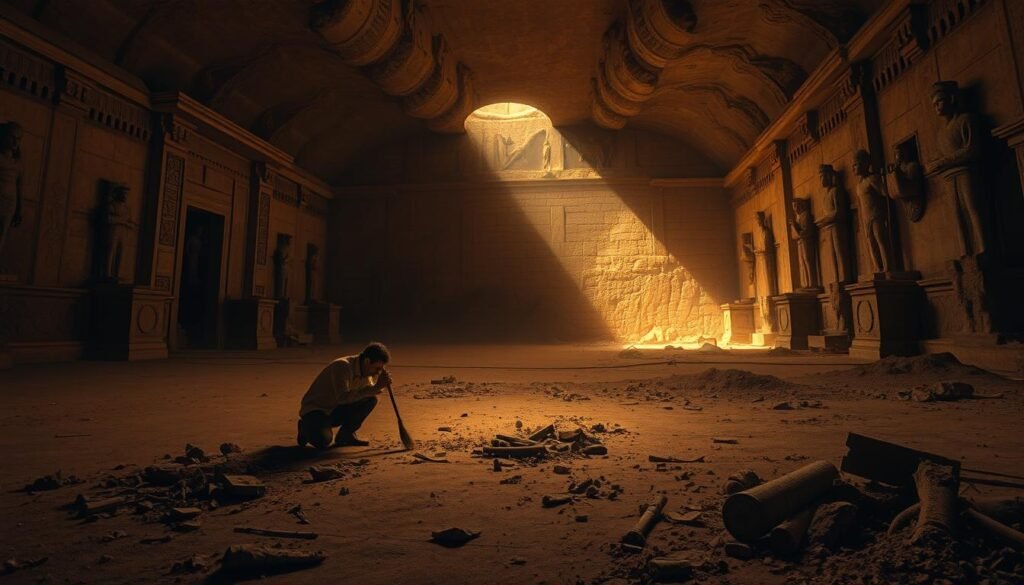
The 2025 list of endangered cultural sites covers many places and times. It was chosen based on how big the threats are and how well they can be saved. This year, 25 sites are on the list, each with its own story of human history at risk.
Criteria for Inclusion
The World Monuments Fund carefully picks sites for the watch list. They look at four main things: the severity of immediate threats, how important the site is, how urgent it is to act, and how much good preservation can do for the community.
People from all over, like heritage experts and local groups, suggest sites. A team of experts then checks each site’s history, threats, and if it can be saved. They pick sites where quick action can really help.
They focus on places where local people are working to save them. This way, they make sure their efforts are most effective.
This year, sites like the Buddhist Grottos of Maijishan and Yungang in China are on the list. These ancient cave temples are at risk from too many tourists and environmental damage. They are filled with old sculptures and paintings.
The Cinema Studio Namibe in Angola is also new to the list. It’s the first site from Angola. This building shows the country’s history and culture from the 20th century.
The Chief Ogiamien’s House in Nigeria is also on the list. It’s very old and might hold secrets of building that could help us in the future.
The Moon is also on the list for the first time. As we explore space more, saving our footprints and artifacts on the Moon is very important.
Zambia is on the list for the first time too. This adds to the variety of ancient ruins and cultural sites that need our help. It shows that saving heritage is a global effort.
Climate Change: The Greatest Threat to Cultural Heritage

Climate change is a big threat to cultural sites worldwide. It’s causing more damage than any other challenge. The climate change impact on our cultural heritage is urgent and widespread.
In Maine, 66 historic lighthouses are at risk from rising seas and strong storms. In January, storms caused $5.5 million in damage. These lighthouses have guided sailors for centuries.
East Africa’s Swahili Coast is also facing threats. Coastal erosion and storms are damaging historic sites. Local communities are trying to protect these sites from the sea.
In Peru, the Waru Waru Agricultural Fields are struggling with drought. These ancient fields were designed for specific weather conditions. Now, changing weather patterns are disrupting them.
Climate change makes other threats worse. It causes wood to decay faster and mold to grow in buildings. It also cracks stone and dries out fertile lands.
But there’s a silver lining. Heritage sites hold traditional knowledge that can help us adapt to climate change. Our ancestors’ innovations can teach us about sustainability.
Efforts to save these sites are now focusing on climate resilience. Site managers are coming up with plans to protect them. Sustainable tourism is helping fund these efforts, balancing visitors with environmental care.
Conflict Zones: Heritage Sites in War-Torn Regions
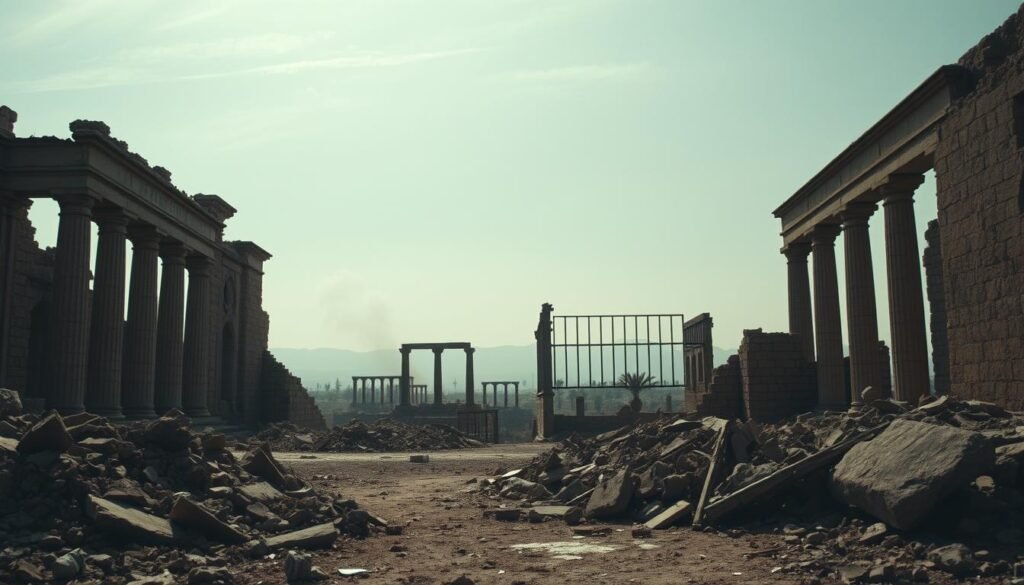
In war-torn areas around the world, cultural sites are at risk. They face threats from intentional destruction, accidental damage, and theft. The harm from war goes beyond people to the heart of culture and history.
Gaza is a dire example on the 2025 Watch list. The military attacks have hurt both people and the area’s culture. In just six months, 60% of Gaza’s cultural sites have been harmed or lost. This includes ancient Tell el-‘Ajjul, St. Hilarion monastery, and a 13th-century palace.
Ukraine’s Kyiv Teacher’s House is another sad case. It was hit by a missile in 2022. This shows how even important cultural and educational sites are targeted in war.
In Spain, the ruins of Old Belchite remind us of the Spanish Civil War’s destruction. Unlike many, Old Belchite was left damaged to show war’s impact on culture.
Attacking cultural sites often has a strategic goal. Cultural preservation experts say it’s to erase memories and identity. This removes a people’s link to their history.
The destruction of cultural property constitutes an attack on the identity and collective memory of communities.
Protecting sites in conflict zones is hard. Safety issues block conservationists, and human needs often come first. Digital tools help monitor sites from afar.
There are laws like the 1954 Hague Convention to protect cultural sites. But enforcing them is tough, mainly when sites are targeted on purpose.
Protecting heritage in war zones needs global effort. This includes diplomatic actions, emergency plans, and rebuilding after war. Without these steps, valuable history will keep disappearing in war’s chaos.
Urbanization and Development: Progress at What Cost?

The push for modern development often clashes with ancient cultural sites. As cities grow and economies boom, the need for new buildings and roads increases. This puts historic landmarks at risk.
The Qhapaq Ñan Andean road system is a prime example. It stretches across six countries in South America and was named a UNESCO World Heritage site in 2014. Yet, it faces threats from development and environmental changes, endangering its ancient sites and petroglyphs.
In India, the Musi River’s historic buildings are under pressure from Hyderabad’s growth. These buildings hold centuries of cultural history. Now, they face competition from new roads and commercial projects.
Development also brings indirect threats. Pollution and construction vibrations can harm ancient materials. Modern buildings can overshadow historic sites, and traditional ways of life are lost as communities modernize.
Development and heritage preservation need not be mutually exclusive. When we integrate cultural heritage into urban planning from the beginning, we create cities that honor their past while building their future.
Global conservation efforts aim to find a balance. Adaptive reuse gives old buildings new life while keeping their essence. Heritage impact assessments help spot problems early. Some cities include cultural heritage in their plans, seeing history as a key to identity and tourism.
There are success stories where careful development has helped preservation. Historic areas that get investment can see economic benefits that fund restoration. The challenge is to apply these strategies in areas where short-term gains often overshadow long-term heritage.
Most Endangered Archaeological Sites of 2025
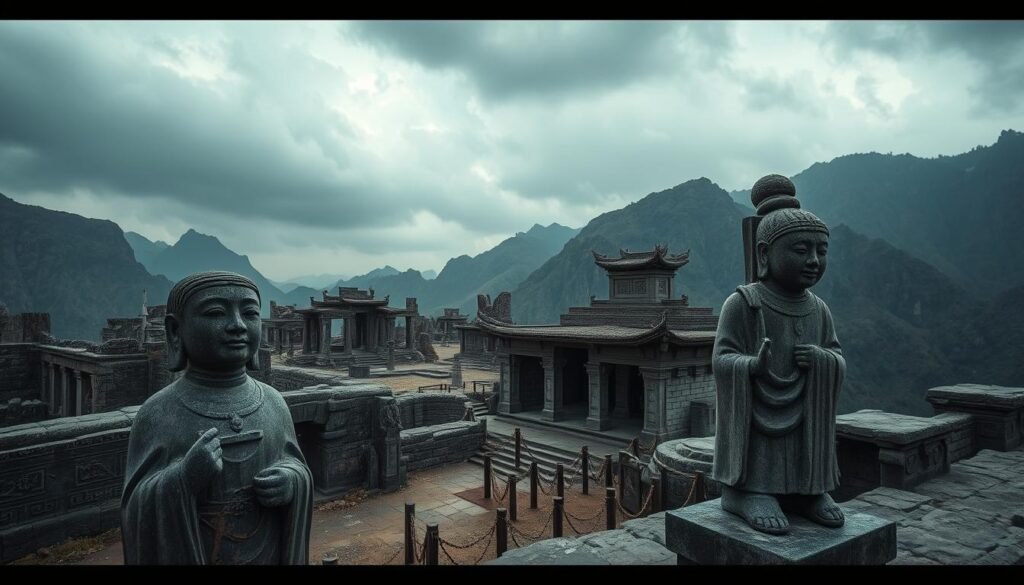
The world’s most endangered archaeological sites of 2025 are precious windows into human history. They face threats like climate change and mass tourism. We must act fast to save them for future generations.
The Buddhist Grottos of Maijishan and Yungang in China are at high risk. These cave temples, carved into cliffs, hold valuable Buddhist art and architecture. Despite being UNESCO World Heritage sites, they struggle with modern challenges.
Mass tourism is the biggest threat to these grottos. Thousands of visitors each day cause damage. The World Monuments Fund says we need new ways to manage visits.
The Qhapaq Ñan Andean Road System is another endangered site. It spans six South American countries and is over 18,000 miles long. Today, it faces threats from development and weather.
Archaeological sites have unique preservation challenges. Their remote locations make monitoring hard. They are also vulnerable to erosion and looting.
Climate change adds to these problems. It causes flooding, drought, and rising sea levels. Coastal sites face saltwater damage, while inland sites weather faster.
New ways to save these sites offer hope. Digital technologies create detailed 3D models. Community programs and sustainable tourism help fund preservation.
These sites are more than tourist spots. They are vital records of human history and culture. Losing them would erase parts of our understanding of civilization.
Indigenous Cultural Heritage on the Brink
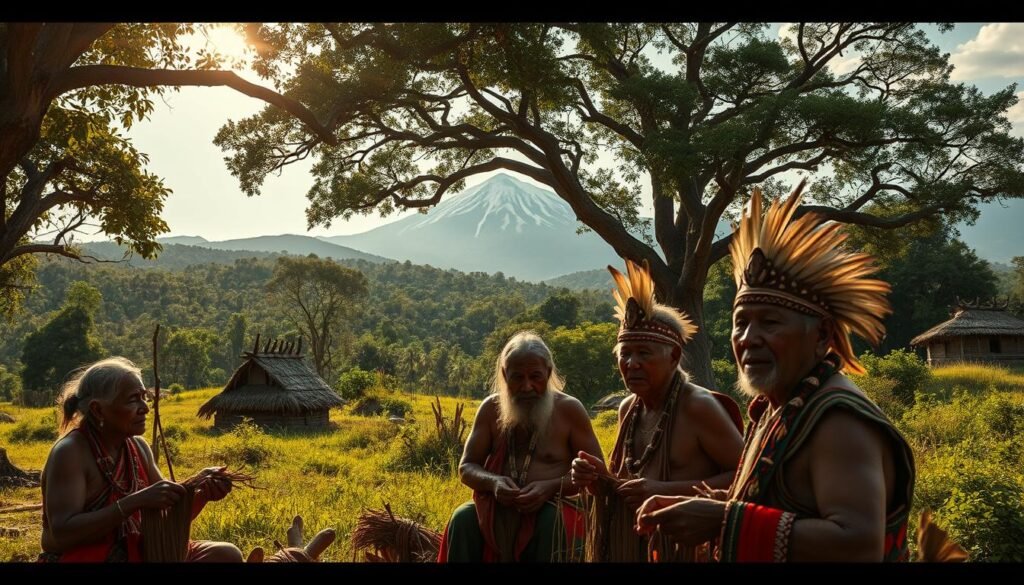
In 2025, indigenous communities worldwide are fighting to save their cultural heritage. They face challenges from development, climate change, and historical marginalization. These threats harm both physical items like sacred sites and intangible things like languages and ceremonies.
The Great Trading Path in the American Southeast is a prime example. This ancient route was key for trade and connection among Native peoples. Now, it’s threatened by industrial development and lack of recognition.
For the Occaneechi People, this path is sacred. It connects them to their ancestors. It holds ceremonial value and contains burial grounds. Without protection, this cultural link could be lost forever.
Our ancestors walked this path for thousands of years. It’s not just land—it’s our identity, our history, and our future all in one.
The Barotse Floodplain Cultural Landscape in Zambia also faces danger. Traditional practices and ecological knowledge are threatened by environmental changes. In Peru, the Waru Waru Agricultural Fields show ancient farming techniques that could help today’s agriculture.
Indigenous heritage is vulnerable due to colonization and ongoing marginalization. Many sites lack legal protection, and communities often have little control over their lands. As elders pass away, traditional knowledge is at risk of being lost.
Indigenous-led preservation efforts are growing. Communities are using traditional and modern methods to protect their heritage. The World Monuments Fund supports efforts to honor the Great Trading Path and increase indigenous involvement in decision-making.
These efforts show that indigenous cultural knowledge is valuable to everyone. It offers insights into sustainable living and environmental care that are essential for our future.
Digital Threats and Technological Solutions
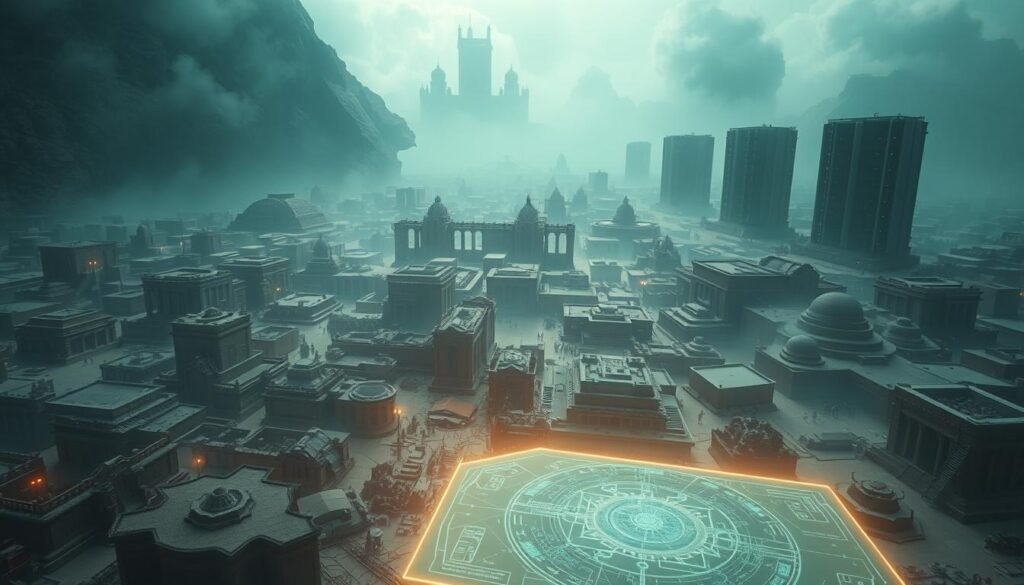
For the first time, endangered cultural heritage now includes the Moon. The World Monuments Fund has added the Moon to its 2025 list. This is due to risks from private space ventures.
“The Moon is a shared human legacy,” says WMF President Bénédicte de Montlaur. “It’s in our stories and history. Now, it faces threats from private interests.”
Lunar sites are mostly untouched because of the Moon’s environment. But, uncontrolled commercial activities could harm them. This shows how global conservation efforts are growing in new ways.
On Earth, sites also face digital threats. Drones and virtual reality tourism pose risks. But, technology can help protect them.
Tools like 3D scanning and photogrammetry are changing how we save sites. In Gaza, digital maps help track damage. Remote sensing tracks climate effects on sites like Maine’s lighthouses.
Technology also brings experts together worldwide. It lets us explore sites in hard-to-reach places. This is a big step forward for conservation.
But, there are digital preservation challenges. Groups must find ways to keep data safe and use common practices. If not, digital records could fail like the sites they document.
In this digital world, we must find a balance. We need to use new tech to protect our cultural heritage. This is true for sites on Earth and beyond.
How You Can Help Protect Endangered Heritage Sites
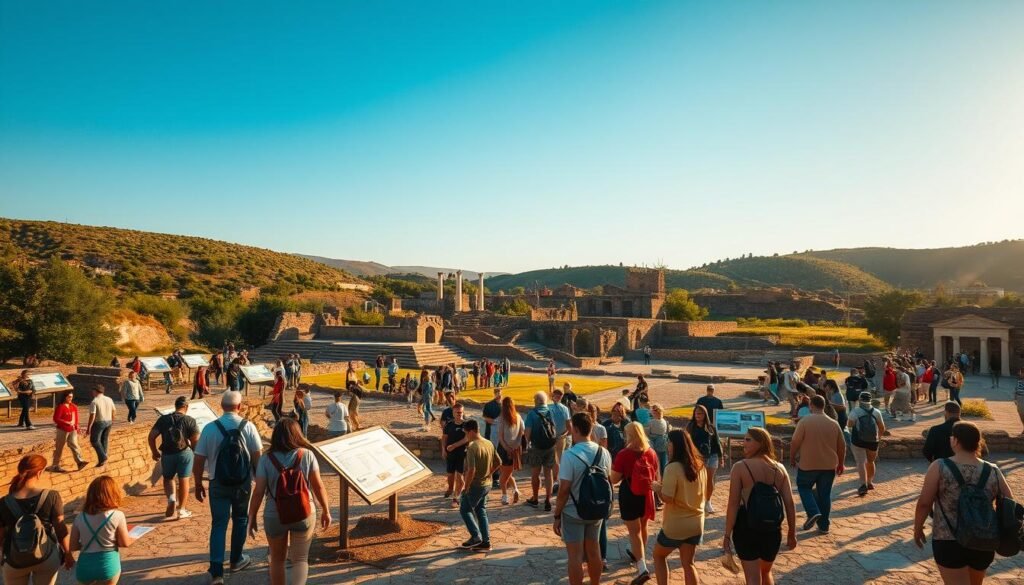
Every person can help save our planet’s most threatened cultural landmarks. The World Monuments Fund has raised $2 million for new projects. But, they need more support from people like you.
Practicing sustainable tourism is a great way to help. Before you visit, check the site’s status and rules. Choose tours that care about the environment and hire local guides. Always follow the site’s rules to leave a small footprint.
Even small donations help a lot. Groups like the World Monuments Fund, UNESCO, and local groups use your money for urgent site needs. Many offer membership to keep you updated on their work.
Your voice can help spread the word. Share info about endangered sites on social media. Talk to heritage groups online and push for better protection with your local leaders. These steps help push for real change.
The preservation of our cultural heritage is not just the responsibility of experts and governments—it’s a collective effort that requires the participation of communities worldwide.
Think about volunteering your time and skills. Many sites need help with projects, digs, or upkeep. If you can’t travel, join digital preservation efforts like transcription or mapping.
Support local craftspeople and businesses in heritage areas. Their work keeps traditions alive and helps the local economy.
Get involved in your community’s preservation efforts. The skills and knowledge you gain can help globally. By doing this, you join a worldwide effort to protect our cultural heritage for future generations.
Conclusion: Preserving Our Shared Human Legacy
The world’s cultural treasures are facing big challenges in 2025. From ancient temples to indigenous knowledge, these treasures tell our shared story. They matter no matter where you’re from.
Climate change and wars are big threats. They damage ancient sites and put valuable artifacts in danger. Also, cities growing and neglecting sites have harmed them for centuries.
But there’s hope. De Montlaur said, “We hope to restore heritage after peace returns.” This dream is for all sites at risk, not just in war zones.
UNESCO sites show our best work, but preserving culture goes beyond them. It includes local traditions, languages, and practices that define communities. Supporting preservation helps protect human stories and knowledge.
We need a balance between growing and saving. This requires new tech, money, and working together across cultures.
Your actions count. By learning about endangered sites, supporting preservation, and traveling responsibly, you help protect our heritage. You join a global effort to save our past for the future.
Our human story is worth saving. With your help, it will be.
